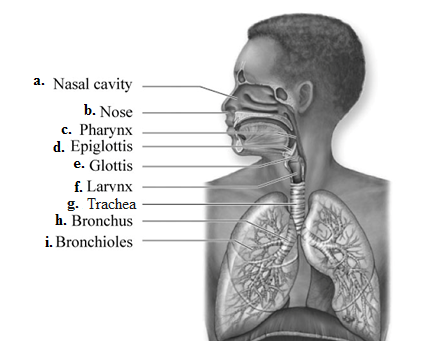
To identify:
The parts of the human respiratory system.
Introduction:
Human respiratory system is an organ system that is related to life supporting breathing process that is taking in oxygen and exhaling out carbon dioxide. It consists of several parts like the bronchi, alveoli, lungs, nostrils and many more. Every organ performs different functions.
Pictorial representation:

Fig.1: The parts of human respiratory system.
Explanation of Solution
(a) Nasal cavity: It is the empty space from where the oxygen enters the respiratory tract and carbon dioxide leaves the respiratory tract. It is also the first part and the opening of the respiratory tract.
(b) Nose: It is also called nares. It has hairs and there is also the lining of mucosal epithelial cells. There function is to trap dust, germs and small insects that enter through the air in our body.
(c) Pharynx: It is the cavity that is covered by membrane. It is found behind the nose and the mouth. It connects the esophagus with the nose and the mouth.
(d) Epiglottis: It is a flap-like structure that guards the opening and the closing of the wind pipe and thereby it protects humans from the entry of food in the windpipe.
(e) Glottis: It is a part of larynx that has vocal cords and it has a slit-like opening between the vocal cords. Glottis affects the pitch of the voice by its contraction and relaxation.
(f) Larynx: It is a hollow organ that is made up of muscle cells. It forms an air passage for the air to pass to the lungs. It also holds the Adam’s apple.
(g) Trachea: It is a C shaped structure that is made up of cartilage. It is also called the windpipe. It connects larynx and the esophagus.
(h) Bronchus: Bronchus is the structure that originates from trachea. They further branch into lobular structures called the bronchioles.
(i) Bronchioles: These are the minute branches that originate from bronchi. They are a connecting link between alveoli and bronchi. They do not contain any cartilage.
Several organs of the respiratory system are the trachea, bronchi, alveoli, and so on.
Want to see more full solutions like this?
Chapter 10 Solutions
Human Biology Lab
- Which of the following is not a DNA binding protein? 1. the lac repressor protein 2. the catabolite activated protein 3. the trp repressor protein 4. the flowering locus C protein 5. the flowering locus D protein 6. GAL4 7. all of the above are DNA binding proteinsarrow_forwardWhat symbolic and cultural behaviors are evident in the archaeological record and associated with Neandertals and anatomically modern humans in Europe beginning around 35,000 yBP (during the Upper Paleolithic)?arrow_forwardDescribe three cranial and postcranial features of Neanderthals skeletons that are likely adaptation to the cold climates of Upper Pleistocene Europe and explain how they are adaptations to a cold climate.arrow_forward
- Biology Questionarrow_forward✓ Details Draw a protein that is embedded in a membrane (a transmembrane protein), label the lipid bilayer and the protein. Identify the areas of the lipid bilayer that are hydrophobic and hydrophilic. Draw a membrane with two transporters: a proton pump transporter that uses ATP to generate a proton gradient, and a second transporter that moves glucose by secondary active transport (cartoon-like is ok). It will be important to show protons moving in the correct direction, and that the transporter that is powered by secondary active transport is logically related to the proton pump.arrow_forwarddrawing chemical structure of ATP. please draw in and label whats asked. Thank you.arrow_forward
- Outline the negative feedback loop that allows us to maintain a healthy water concentration in our blood. You may use diagram if you wisharrow_forwardGive examples of fat soluble and non-fat soluble hormonesarrow_forwardJust click view full document and register so you can see the whole document. how do i access this. following from the previous question; https://www.bartleby.com/questions-and-answers/hi-hi-with-this-unit-assessment-psy4406-tp4-report-assessment-material-case-stydu-ms-alecia-moore.-o/5e09906a-5101-4297-a8f7-49449b0bb5a7. on Google this image comes up and i have signed/ payed for the service and unable to access the full document. are you able to copy and past to this response. please see the screenshot from google page. unfortunality its not allowing me attch the image can you please show me the mathmetic calculation/ workout for the reult sectionarrow_forward
 Human Anatomy & Physiology (11th Edition)BiologyISBN:9780134580999Author:Elaine N. Marieb, Katja N. HoehnPublisher:PEARSON
Human Anatomy & Physiology (11th Edition)BiologyISBN:9780134580999Author:Elaine N. Marieb, Katja N. HoehnPublisher:PEARSON Biology 2eBiologyISBN:9781947172517Author:Matthew Douglas, Jung Choi, Mary Ann ClarkPublisher:OpenStax
Biology 2eBiologyISBN:9781947172517Author:Matthew Douglas, Jung Choi, Mary Ann ClarkPublisher:OpenStax Anatomy & PhysiologyBiologyISBN:9781259398629Author:McKinley, Michael P., O'loughlin, Valerie Dean, Bidle, Theresa StouterPublisher:Mcgraw Hill Education,
Anatomy & PhysiologyBiologyISBN:9781259398629Author:McKinley, Michael P., O'loughlin, Valerie Dean, Bidle, Theresa StouterPublisher:Mcgraw Hill Education, Molecular Biology of the Cell (Sixth Edition)BiologyISBN:9780815344322Author:Bruce Alberts, Alexander D. Johnson, Julian Lewis, David Morgan, Martin Raff, Keith Roberts, Peter WalterPublisher:W. W. Norton & Company
Molecular Biology of the Cell (Sixth Edition)BiologyISBN:9780815344322Author:Bruce Alberts, Alexander D. Johnson, Julian Lewis, David Morgan, Martin Raff, Keith Roberts, Peter WalterPublisher:W. W. Norton & Company Laboratory Manual For Human Anatomy & PhysiologyBiologyISBN:9781260159363Author:Martin, Terry R., Prentice-craver, CynthiaPublisher:McGraw-Hill Publishing Co.
Laboratory Manual For Human Anatomy & PhysiologyBiologyISBN:9781260159363Author:Martin, Terry R., Prentice-craver, CynthiaPublisher:McGraw-Hill Publishing Co. Inquiry Into Life (16th Edition)BiologyISBN:9781260231700Author:Sylvia S. Mader, Michael WindelspechtPublisher:McGraw Hill Education
Inquiry Into Life (16th Edition)BiologyISBN:9781260231700Author:Sylvia S. Mader, Michael WindelspechtPublisher:McGraw Hill Education





